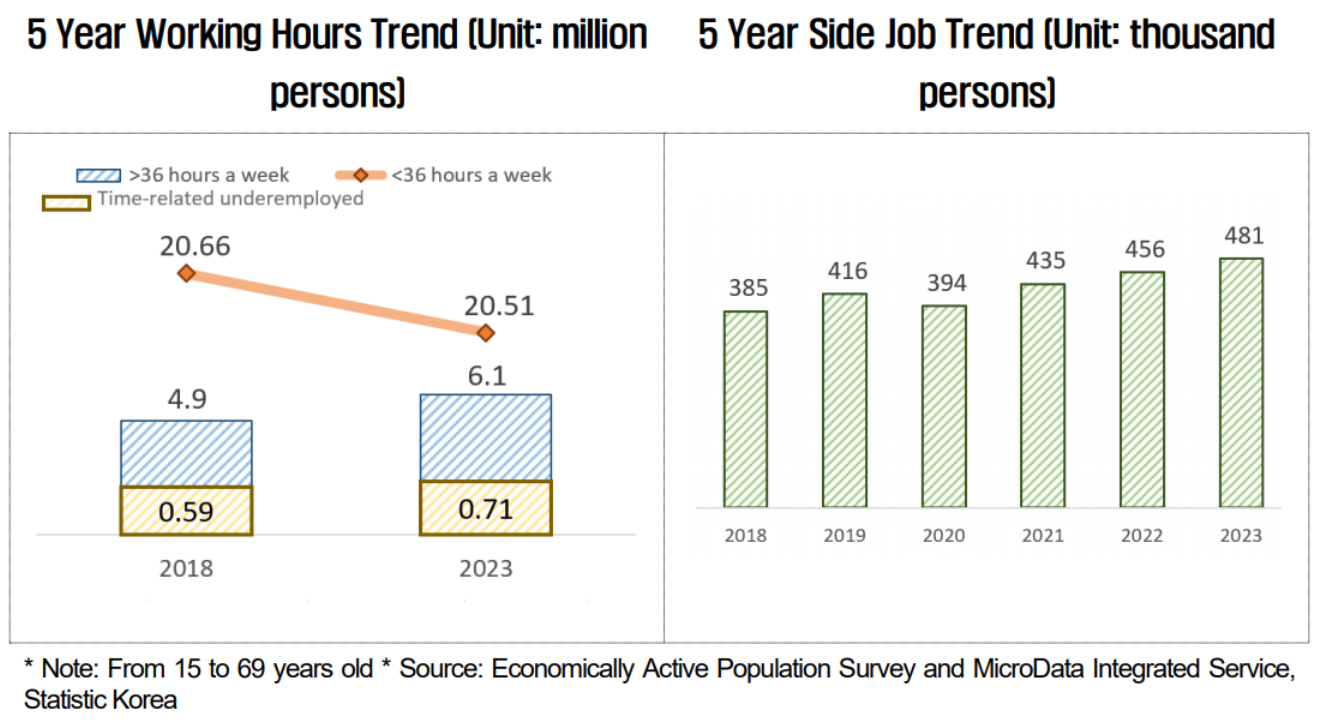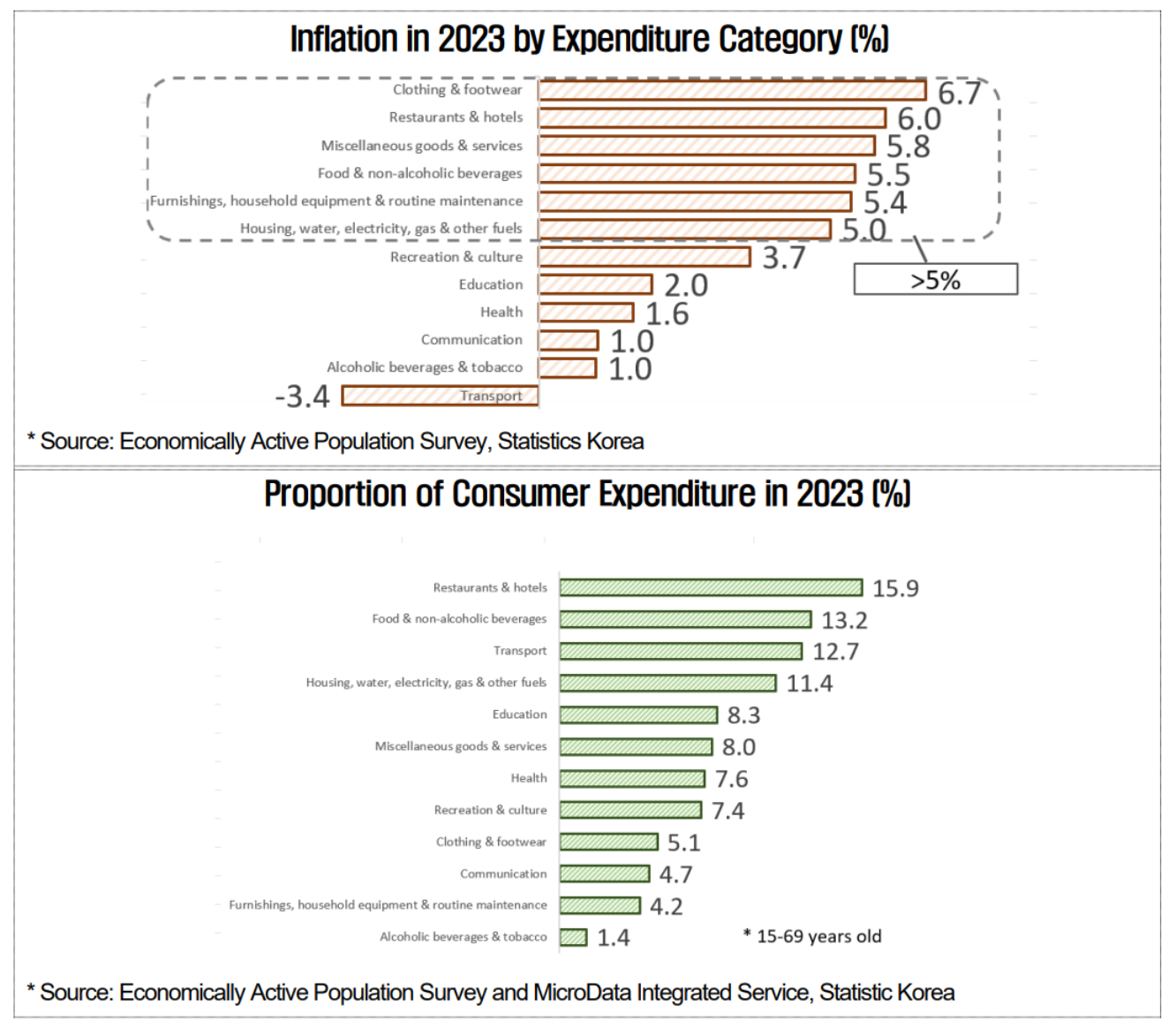News & Events
Press Releases
Misery Index: Trends and Analysis
|
2023 Misery Index1 Improved to Pre-COVID Levels (2018-2019) Due to Drop in Real Unemployment Rate
• (* Misery Index – 2018: 12.9 → 2019: 12.0 → 2020: 14.1 → 2021: 15.8 → 2022: 15.8 → 2023: 12.5)
"Analysis of the Misery Index Over the Last 5 Years (2018–2023)"
• 2023 real unemployment rate2 : 9.0% - 2.4-2.7%p improvement compared to pre-COVID levels (2018–2019)
* Real unemployment rate (%): 2018: 11.4 → 2019: 11.7 → 2020: 13.6 → 2021: 13.2 → 2022: 10.6 → 2023: 9.0
• 2023 real inflation rate3 : 3.5% - 2.0 to 3.2 percentage points worse than before the pandemic (2018-2019)
* Real inflation rate (%) – 2018: 1.5 → 2019: 0.3 → 2020: 0.5 → 2021: 2.6 → 2022: 5.2 → 2023: 3.5
• Decline in employment quality with increase in time-related underemployed and those working side jobs over 5 years
* 0.8% decrease in full-time workers over 5 years vs. 19.7% increase in time-related underemployed4, 24.9% increase in those working side jobs
• High inflation burden in high-expenditure categories of ‘restaurants and hotels' (6.0%↑) and 'food' (5.5%↑)
• Need to create a business-friendly environment to create quality jobs and stabilize the cost of living
1 The misery index (of Korean 15 to 69-year-olds) is a version of the first Misery Index created by Arthur Okun, an American economist, and in this study, it is calculated through the real unemployment rate and the real inflation rate. The higher the index value, the greater the economic distress of the people.
2 The real unemployment rate is the unemployment rate calculated by also counting those who are not captured by official unemployment statistics such as part-time workers, job seekers, and discouraged workers as unemployed.
3 The real inflation rate is calculated by weighing the proportion of consumption expenditures by category (e.g., food, medicine, etc.) among the consumption expenditures of the population aged 15 to 69 years and using the weighted average of CPI (all ages) to calculate the year-on-year CPI increase (all ages)
4 Workers who work less than 36 hours per week who want to work more hours and can take on additional employment.
In 2023, the Misery Index (of those aged 15-69) was 12.5, an improvement near the levels of 2018 (12.9) and 2019 (12.0) before the COVID-19 pandemic, and a 3.3-point drop from the year before (2022: 15.8).

The FKI cited a decline in the real unemployment rate5 as the main reason for the improvement in the Misery Index last year. In fact, the unemployment rate increased from 11.4% in 2018, peaking at 13.6% in 2020, before stabilizing at pre-COVID levels at 9.0% in 2023.
5 Real unemployment rate (%): {Unemployed persons + time-related underemployed persons + potential employable persons + potential job seekers} ÷ Extended economically active population (Economically active population + unavailable jobseekers + available potential jobseekers) × 100
‣ Time-related underemployed persons: people who work short hours such as part-time jobs but want to work more hours in the future
‣ Unavailable jobseekers: people who are economically inactive and have made efforts to find a job, but are unable to start working immediately due to childcare, etc.
‣ Available potential jobseekers: people in the economically inactive population who have not recently looked for a job, but are willing and able to work.
The real inflation rate spiked to 5.2% in 2022 before slowing to 3.5% in 2023, but it's still higher than the 0–1% range of 2018–2020.

Decline in employment quality with 19.7% increase in time-related underemployed persons and 24.9% increase in those working side jobs in 5 years
In 2023, the real unemployment rate was 9.0%, which is lower than the pre-pandemic levels of 2018 (11.4%) and 2019 (11.7%), but the quality of jobs has fallen.
There were 20.51 million workers who worked 36 hours or more per week in 2023, down 0.8% from 2018 (20.66 million), and 6.05 million workers who worked less than 36 hours per week in 2023, up 22.7% from 2018 (4.93 million).
Among part-time workers working less than 36 hours a week, the number of young people who want to work more hours has also increased. As of 2023, there were 706,000 "time-related underemployed persons", a 19.7% increase from five years earlier (590,000 in 2018).
Also, the number of people who are not satisfied with their current job and are working a second job has also increased. In the five years from 2018 to 2023, the number of people working side jobs increased by 24.9%, from 385,000 to 481,000.
"While employment has been improving as shown in indicators such as the recent decline in the real unemployment rate, the quality of employment seems to be declining due to the increase in part-time workers and those working side jobs," the FKI said, adding, "It seems that the quality of jobs needs to be improved, such as increasing full-time jobs."

High expenditure categories like restaurants and hotels (6.0%↑) and food(5.5%↑) facing high inflation
According to the Consumer Price Index by expenditure category released by Statistics Korea, the inflation rate was higher than 5% in the following categories: clothing and footwear (6.7%), restaurants and hotels (6.0%), miscellaneous goods and services (5.8%), food (5.5%), and furnishings, household equipment & routine maintenance (5.4%).
Meanwhile, the share of consumption by expenditure category for 15–69-year-olds in 2023 was 15.9% for restaurant and hotels, 13.2% for food, and 11.4% for housing, water, electricity, gas and other fuels, indicating that people's consumption expenditure was concentrated in sectors with high inflation.
"Although the recent trend of inflation has slowed down, the burden of inflation felt by the general public is still high due to the high rate of increase in food prices and utility bills such as electricity and water, which account for a large proportion of people's consumption expenditures," the FKI explained.

"Although the economic difficulties experienced by the public have eased to pre-COVID levels, there are still areas that need to be improved, such as the deteriorating quality of employment and rising prices of major items," said Sang-ho Lee, vice president of the FKI’s Economic and Industrial Research Department. "We need to create the conditions for companies to expand investment and employment by reforming regulation, eliminating labor market rigidity, and increasing tax support, and work to stabilize the cost of living."